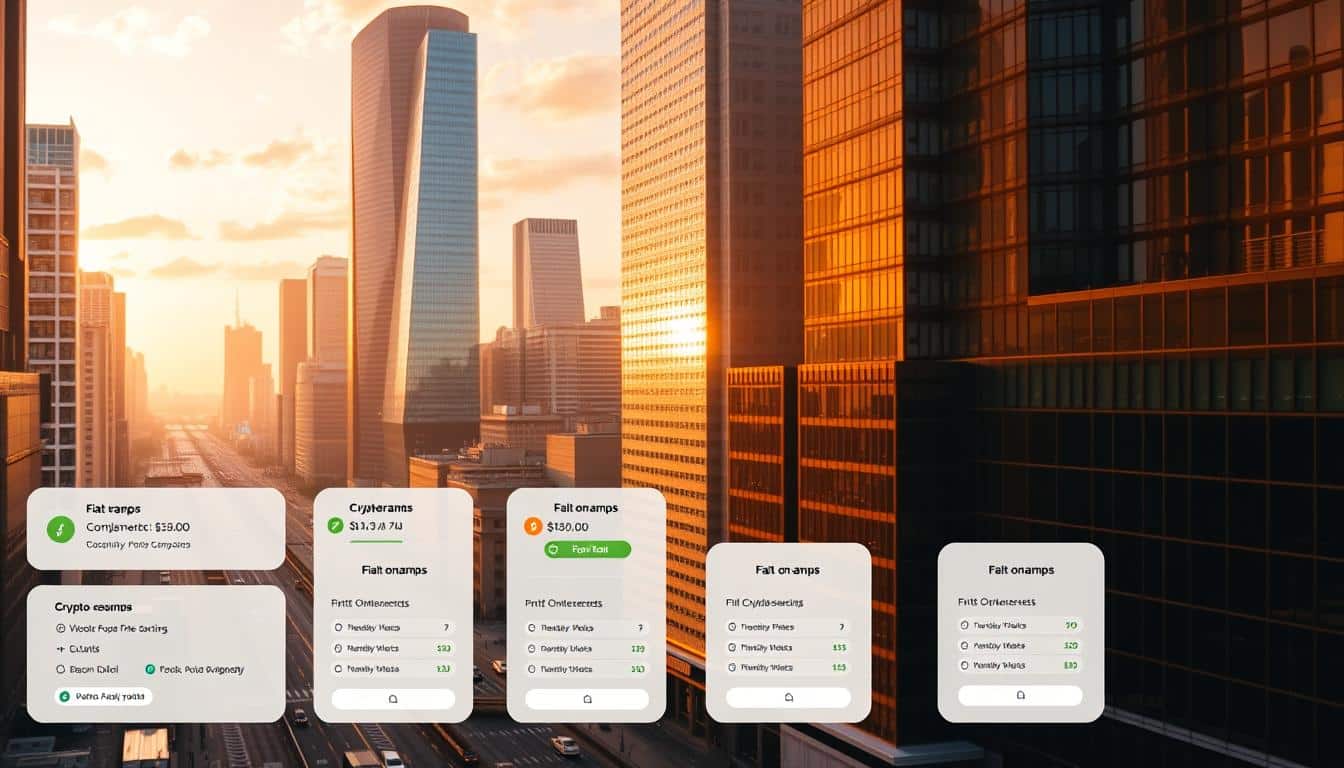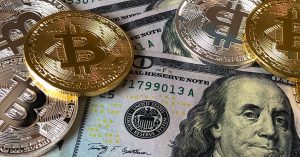Last year, big moves in the crypto world made it clear that easy access from regular money to crypto is crucial. For example, Ethereum whale transactions exceeded $205.48 million, and Ethereum ETFs had inflows near $12.96 billion, as per Arkham and SoSovalue data. These actions show how regular buyers are impacted and increase the need for good fiat on-ramps for crypto buys.
I’ve been checking out well-known services for months. I looked at how Coinbase welcomes users, how Binance works worldwide, and how Kraken handles money, all to find an answer. The question was: which fiat to crypto gateways really help those not into trading much?
I tested these services with various people. This group included waiters, bartenders, teachers, electricians, and office clerks. They all seek easy methods to switch USD to crypto. Predictions say crypto payments could hit the trillions from 2026 to 2030, making the need even more pressing.
This brief guide discusses the top platforms for buying crypto with regular money. It compares costs and user experience, looks at security, notes growth signs, and mentions helpful tools. I’ve used platform rules and market facts to help you choose confidently.
Key Takeaways
- On-ramps matter more now because large institutional flows and whale purchases increase demand.
- Coinbase, Binance, and Kraken each serve different user needs — ease, global reach, and security.
- Fees, verification time, and payment methods drive real-world usability for nonprofessional buyers.
- Look for platforms with strong regulatory compliance and clear user protections.
- Projected growth in crypto payments will make trusted fiat gateways for cryptocurrency purchases even more critical.
Understanding Fiat On-Ramps and Their Importance
I began looking into fiat on-ramps because I wanted to invest small savings into crypto easily. They essentially let you swap dollars for assets like ETH or BTC. Some are easy-to-use apps, while others are more complex, integrating with banks and existing finance tools.
What is a Fiat On-Ramp?
A fiat on-ramp is a platform or service where you can exchange fiat currency for cryptocurrency. This includes exchanges like Coinbase and Kraken, noncustodial on-ramps that work with third-party processors, and solutions that work within fintech apps.
Exchanges like Coinbase hold your crypto to make buying easier for new users. Noncustodial options give you more control over your keys but might be a bit more complex. Solutions integrated with banking allow seamless money transfers between your bank and crypto wallets.
How Fiat On-Ramps Work
On-ramps generally follow these steps: verify your identity, add funds, place an order, pick a custody method, and then finalize the transaction. You’ll often need to provide ID and sometimes a selfie. You can fund your account in different ways like ACH, wire transfers, or using a debit card.
ACH transfers usually take 1–5 days. Buying with a debit or credit card is quicker but costs more. You can buy at the current market price or set a price with a limit order. Then, you can keep your crypto on the platform or move it to your personal wallet.
Why They Matter for Crypto Adoption
Easy-to-use on-ramps attract more people to crypto. This includes service workers, teachers, nurses, and gig workers. More people buying crypto leads to more money flowing through the system, which sparks innovation.
Trends like big institutions investing in ETH and the popularity of DOGE raise public interest. Fintech companies that blend banking with crypto are setting new expectations for easy fiat-to-crypto switching.
Regulations are also key. Clear, fair rules can make people trust and use these services more. But strict regulations might slow things down. What usually makes a service stand out includes low fees, a good mobile app, and transactions that you can count on.
Top Fiat On-Ramps for Crypto Purchases
I’ve looked into many platforms for moving money into crypto. Each one offers different speeds, fees, and support depending on where you are. Below, I share details on three main options many choose for buying crypto with fiat. I’ll cover who they’re best for and what to expect with verification and putting money in.
Coinbase: A Beginner-Friendly Option
Coinbase is easy for starters and has a user-friendly setup. It’s a well-known name in the U.S., and people trust it. I’ve noticed that the ID checks are usually quick, but can be slow when it’s busy.
To get verified, you’ll need a photo ID and a selfie, sometimes your address too. You can use debit cards for fast buys and ACH for cheaper deposits. There are extra costs with card purchases and price differences with instant buys. Coinbase Pro is there for those trading more, with detailed fees and better pricing.
Here’s an idea: use a bank link for less expensive ACH transfers if you’re not in a hurry. It’s best for newbies and casual buyers who want easy use and to learn through Coinbase Learn. Coinbase Wallet is great for holding your crypto later on.
Binance: Global Accessibility
Binance stands out for working in many places and offering lots of altcoins. It’s noted as a top choice for buying crypto around the world if you’re not in the U.S.
For verification, a standard process of KYC with ID and selfie is needed. Deposit methods change by country – like bank transfer, card, other ways, and P2P. Its fees are low, and it’s good for getting altcoins because it has a lot of choices and liquidity.
What you can do and limits can differ by place. Binance.US is more limited due to local laws. It’s recommended for world traders and those after altcoins who want low costs and variety.
Kraken: Security and Variety
Kraken puts a big focus on being secure and following rules, which appeals to those who want safety first. Their careful way attracts investors looking for protection over extra features.
Verification involves different levels, needing identity papers and sometimes proof of funds for more access. In the U.S., you can use ACH, wire transfers, or SWIFT for international banks to deposit. ACH can take days, while wires are quicker.
For those trading more actively, there are advanced order and margin options. Customer service can be hit or miss, but they’re strong on security. This is aimed at careful investors and more experienced traders who need good fiat options and care about rules.
If you’re after a quick guide on reliable fiat to crypto exchanges, these three are often praised for their ease of use, range, and trustworthiness. I keep accounts with at least two to manage liquidity and regional restrictions better. This strategy helps switch platforms smoothly for different needs or chances.
Detailed Comparison of On-Ramp Fees
I keep an eye on fees like some do with the weather. Small changes can greatly impact costs. Here, I explain different fee models, their effects on purchasing, and my go-to sources for comparing current rates.
Typical Fee Structures
Many platforms use various fee models. These include flat fees for card buys, percent fees ranging from 1.49% to 3.99%, and spreads in quoted prices. ACH transfers are cheaper but slower, while wire transfers cost more due to bank fees.
Additional fees come into play with platforms like Coinbase, Binance, and Kraken. They charge for trading when you switch fiat to crypto. Card buys might bring extra charges from your bank. And using non-USD can add foreign exchange fees.
How Fees Affect Your Purchase
Let’s use numbers for clarity. Buying with a $200 debit card at 3.99% costs you $7.98 in fees. If you use an ACH method with a 0.5% spread, the direct fee is $1. However, the real cost might be higher due to spread and network fees.
Big orders can alter calculations. Market shifts can widen spreads and increase slippage. With high demand, prices can soar, showing how important it is to know about both visible and hidden fees.
For smaller, regular buys, using ACH routes is usually more wallet-friendly than instant card purchases. However, if you’re in a hurry, ready yourself to pay more for quick buys on top sites.
Resources for Fee Comparison
I have a list of reliable sources. I mainly check official fee info on Coinbase, Binance, and Kraken. Tools and community posts also give updates on rates and offer comparisons between card and ACH fees.
Third-party sites are good for spotting differences. Forums can alert you to extra charges like bank holds. For safety, choose exchanges that show all their fees and are well-reviewed by users.
A useful tip: always do the math before buying. Remember to include potential extra charges from your bank and for currency exchange. This approach helps reveal any hidden expenses and leads you to the most cost-effective option for your crypto purchases.
User Experience: How to Choose the Right Platform
Choosing an exchange isn’t just about fees or the cryptocurrencies offered. I focus on how the site feels during everyday use. A good platform makes it easier when you’re in a rush and reduces mistakes. I look for a balance between easy use and having control. This way, I can find the best places to switch money into crypto that meet my needs.
Interface and Usability
Coinbase has a simple, clean design that new users appreciate. It guides them step by step and labels everything clearly. Binance, on the other hand, is packed with features. For experienced users, it offers detailed charts, various types of orders, and quick ways to add money. But, it’s a bit harder to learn.
Kraken finds a middle ground. It’s professional yet doesn’t scare away newcomers. I organize orders and look at charts on my computer. But I switch to my phone for fast buys. This shows which fiat to crypto methods are truly useful, beyond just hype.
Customer Support and Resources
The quality of support differs by platform. Coinbase and Kraken offer ticket support and have detailed help sections. Binance combines thorough guides with a lively user community. However, support can be slow sometimes, like during heavy user sign-ups or market crashes.
Once, I experienced a delay in verification when the market was very active. Being able to buy quickly was crucial then. It’s important to understand deposit and withdrawal rules before adding your money. Websites like Coinbase Learn, Binance Academy, and Kraken Learn are great for filling in knowledge gaps quickly.
Mobile Apps vs. Desktop Trading
Mobile apps are essential for staying connected on the move. Workers and people commuting often use apps for instant purchases and easy logins. I use my phone for regular buys and to stay updated.
But for in-depth analysis, desktops are better. They can handle multiple windows, complex charts, and detailed order setups. I set up everything on my computer first, then use my phone for quick purchases. This strategy lets me be efficient and make the most of the top methods for changing money into crypto.
When deciding, think about what’s most important to you. For simplicity, choose a platform with an easy flow. If you need more control, go for one with lots of features. Consider the quality of support, what resources are available, and whether you’ll mainly use a computer or phone. This can help you pick the best fiat to crypto options for your lifestyle.
Security Features to Look For
When I invest in crypto, keeping my money safe is my top priority. I always pick the most secure ways to turn my cash into cryptocurrency. This means using trusted exchanges and gateways, which reduces my worries. It also keeps my money safe during sudden market changes or if someone tries to hack my account.
I start by setting up strong ways to log in. I prefer using hardware security keys and apps like Google Authenticator or Authy. I stay away from SMS-based 2FA because of the risks of SIM-swap attacks.
It’s important where a platform stands with regulations. I look for those registered with FinCEN or those that have a BitLicense. This shows they follow the rules and are open about their operations. Before I trust a platform, I also check if they have proof of their reserves and if they get audited regularly. This helps me find stable and reliable gateways for my crypto purchases.
Understanding the insurance coverage is key. While some exchanges offer insurance against hacks, this often doesn’t cover mistakes made by the user, like losing their keys. Some platforms protect cash by putting it into FDIC-insured bank accounts. Always read carefully to understand what’s covered and what’s not.
I use different accounts for different needs. For daily trading, I keep a small amount on an exchange. My long-term investments go into a hardware wallet. Setting up withdrawal whitelists and using cold storage help me lower risks, especially during big market movements.
Choosing between security and convenience can be tough. When big players or firms shake up the market, being able to move your money quickly can be crucial. My strategy is to use the fastest fiat-to-crypto services for buying crypto. Then, I move larger amounts to more secure, offline storage.
Here’s a quick guide to help you figure out the best security features on different platforms. It will help you decide based on how much risk you’re comfortable with.
| Security Feature | What to Look For | Examples / Notes |
|---|---|---|
| Two-Factor Authentication | Hardware keys (U2F/WebAuthn), app-based TOTP; avoid SMS | Use YubiKey or Google Authenticator; Authy for multi-device backup |
| Regulatory Compliance | FinCEN registration, BitLicense where relevant, public audits | Platforms that publish audits and proof of reserves signal lower counterparty risk |
| Insurance & Fiat Protections | Exchange-held crypto insurance, fiat swept to insured banks, clear claim process | Coinbase and Kraken have highlighted insurance policies and custodial safeguards |
| Operational Controls | Withdrawal whitelists, cold storage splits, role-based account access | Enable whitelists for large accounts; separate trading vs. custody balances |
| Transparency | Audit frequency, proof of reserves, regulatory disclosures | Prefer platforms that publish reports and respond to independent audits |
| User Protections | Clear dispute and claims process, responsive support, educational resources | Look for timely support and documented steps for filing claims after incidents |
Graph of Cryptocurrency Growth and On-Ramp Usage
I drew a graph to show how cryptocurrency markets, on-ramp usage, and payment forecasts relate. It aims to reveal helpful trends. These trends can guide you in picking the right fiat on-ramps for buying crypto or in comparing the leading on-ramps. I based my findings on various sources like exchange reports and analytic platforms.
Historical Growth Trends
The first graph shows the global crypto market cap from 2016 to 2024. It’s clear to see the cycles of Bitcoin and Ethereum. Ethereum especially saw a huge spike, reaching nearly $4,953 in August. This peak drove lots of retail interest and big buys.
DeFi’s total value locked soared past $100 billion, driving demand for on-chain activities. This demand leads to more exchange deposits.
The second graph tracks how many people and how much money went into fiat-to-crypto on-ramps. We saw a growth spurt when ETFs came in and during uncertain economic times. Retail investors tend to follow the lead of big institutional investors.
Current Statistics on User Adoption
On the graph, specific data points highlight key information. The Ethereum ETFs brought in about $12.96 billion overall. This pushed more liquidity to the markets and on-ramps. Three big buys of Ethereum totaled around $205.48 million, showing up as spikes in activity.
In 2023, crypto payment volumes nearly hit $1 trillion. At the same time, ‘meme’ cryptos like Dogecoin saw huge fluctuations. Dogecoin’s value jumped by 20.7% in just one week. These patterns illustrate how trading and payment volumes influence the preferred ways to switch from fiat to crypto.
Future Predictions for Fiat On-Ramps
The third graph predicts payment volumes up to 2030 with a broad outlook. Estimates range from a conservative $2 trillion to an optimistic $9 trillion. This range is shown with bands for clarity.
Different experts have varying price expectations. Ethereum could reach between $8,000 and $10,000. Dogecoin might hit between $0.80 and $1.55. Stories about digital asset presales like DigiTap suggest it could soar by 2026. But remember, these predictions are based on many factors including adoption rates and regulations.
Underneath the graph, you’ll find notes about how the data was gathered. Sources include reports from exchanges and analytics from websites. This graph should serve as a reference, helping you choose the right fiat on-ramps. It shows where fiat-to-crypto methods have improved and where there’s still work to do.
Tools and Resources for Crypto Buyers
I have a small set of tools for buying and keeping track of cryptocurrency. It helps me do my research without making quick, unplanned purchases. Here, I share the apps, services, and websites I check out a lot.
Price Tracking Applications
I use CoinMarketCap and CoinGecko to see the big picture in the market. They show live prices and histories that I look at every morning.
I get alerts and make watchlists with CoinStats and Delta. For detailed charts, TradingView is the best. It’s useful before buying crypto the easy way.
Portfolio Management Tools
I link my accounts from Coinbase, Binance, and Kraken to CoinStats or Kubera. This lets me see my real gains across different places easily.
Zerion is good for DeFi because it shows on-chain data. I can see my liquidity and token balances all in one spot. It’s great with top places to buy crypto.
Educational Resources
I learn about accounts, fees, and how to use money with Coinbase Learn, Binance Academy, and Kraken Learn. Lex Sokolin’s writings give me a broader view of the market.
I look at Dune Analytics, Chainalysis, and Arkham for deep dives into big transactions. Keeping up with big money helps me make smarter choices.
Some tools I always have are a calculator for deposits, a sheet to compare fees, and guides for setting up wallets. My strategy: research in one place, buy in another. This keeps me from making quick decisions when prices are all over the place.
FAQs About Fiat On-Ramps
People often ask me about starting to buy crypto. I will answer common questions about the easiest platforms, risks to look out for, and comparing payment methods on the best fiat on-ramps.
What is the best fiat on-ramp for beginners?
I usually suggest Coinbase to newbies. It’s user-friendly, with straightforward KYC processes and helpful education sections. It’s also well-regulated in the U.S., making it a top choice.
However, consider the fees and where you live. Beyond Coinbase, Binance, Kraken, or local exchanges might work better for some. It’s wise to make a small test purchase to see fees and transfer speed.
Are there any risks associated with using on-ramps?
Yes, there are risks. High demand can slow down identity checks. Also, if an exchange gets hacked, you might lose money. Regulatory issues can also stop fiat money movements in some areas.
Large purchases can lead to price changes. Bank cards can bring extra fees both from the bank and exchange. For safety, choose trusted exchanges, turn on all security options, and store your crypto in a hardware wallet for long-term holding.
Can I use my debit card for crypto purchases?
Yes, many big exchanges let you buy crypto with a debit card quickly. It’s very handy for fast purchases.
Be ready for higher fees and possibly hitting bank limits. Bank transfers cost less but take longer. I say use cards for quick, small buys and bank transfers for bigger, planned ones to save on fees and avoid card problems.
Case Studies: Successful Fiat On-Ramps
I’ve studied how three big exchanges made it easy to move real money into crypto. These examples show steps taken, choices made, and user-centered actions. They made these platforms top spots for getting into cryptocurrency.
Analysis of Coinbase’s Growth
Coinbase made it simple to start and added learning into the process. It used clear instructions, tutorials, and welcoming messages. This approach helped it become a leader in U.S. retail crypto during important ETF discussions and increased interest from big investors.
It also focused on big investors with custody and prime brokerage tools. These actions attracted big money transfers regularly. It shows how good design and trust put a product top for buying cryptocurrencies.
Binance’s Global Strategy
Binance grew fast by entering new markets and offering various ways to use money. It connected with local banks, created P2P marketplaces, and listed many tokens. This let people in many places change their local money into crypto easily.
Regulations in the U.S. led to Binance.US, a version that followed stricter rules. This move shows how adapting to laws and offering flexible services keep platforms trusted for cryptocurrency buys.
Kraken’s Security Measures
Kraken earned trust with top security and careful choices about what to list. Strong safeguards, frequent checks, and showing reserves attracted those moving big money. Such transparency in handling and compliance is key for institutions choosing a crypto entry point.
Its focus on safety and following rules reassures users doing large transactions. This approach puts security-first exchanges at the top for crypto purchases.
These stories share a theme: platforms that mix rule-following, easy entry, and strong security win both ordinary people and big investors. When the market gets exciting and big players join, these channels offer reliable ways to invest.
For those creating new entry points, working with third-parties can quickly provide funds and make starting easier. Detailed advice for startups is available at startup business planning resources.
Emerging Trends in Fiat On-Ramps
Watching fiat on-ramps grow quickly is fascinating. They’ve changed from slow bank transfers to instant crypto market access. This boosts competition among them. Users seek fiat on-ramps that offer quick access, low costs, and comply with laws.
DeFi isn’t just a hobby zone anymore. Big names like Uniswap and Aave pull direct cash flow from fiat rails. This need drives the creation of decentralized on-ramps and services turning fiat into stablecoins, fueling DeFi’s growth.
The Role of Decentralized Finance (DeFi)
Decentralized on-ramps change currency without a central exchange. They connect bank transactions to smart contracts, letting users deposit money that becomes USDC or USDT in DeFi. Now, DeFi’s top protocols hold over $100 billion at their high points. This has made traditional banks and DeFi tools work better together.
Adoption of Stablecoins
Stablecoins work like digital cash. USDC, USDT, and Paxos Dollar feature in many on-ramp processes. They make moving money internationally faster. Trying out different platforms, I see the user experience improves with seamless conversions. Omni-banking shows accounts in over 100 currencies but uses stablecoins for DeFi transactions.
Predictions for Future Integrations
AI will become more important in on-ramps. It will improve KYC checks and reduce scams. Banks and exchanges will work closer to cut wait times. On-ramps will naturally include KYC/AML, making it easier for everyone to use.
Products that do well will have easy-to-see fees, top-notch security, and be easy to use. Fees will likely decrease, and converting fiat to crypto will get quicker and integrate better with stablecoins. People will prefer using methods that make switching from fiat to crypto as easy as using their phones for banking.
Conclusion: Choosing the Right Fiat On-Ramp for You
Choosing the best fiat on-ramps for buying crypto means considering fees, speed, security, user experience, and what assets you can buy. I’ve learned that these points help ignore the marketing. Coinbase, Binance, and Kraken serve different needs—Coinbase is great for new users, Binance offers a wide range of altcoins, and Kraken is top for those who prioritize security.
Key Takeaways
When buying often, how much it costs and how fast you get your crypto matter a lot. A company’s regulatory status and how well your assets are protected are important for keeping your investment safe. If a platform is easy to use, you’re more likely to stick with your investment plan.
Being able to buy the crypto you want is crucial. For those in the U.S. who enjoy a do-it-yourself approach, stick with Coinbase or Kraken for simplicity. Choose Binance.US or Binance if you’re okay with a bit more complexity but want access to more tokens.
Final Recommendations
Start with an account that has low fees and supports ACH for regular purchases. Keep one exchange for your usual buys and another for trying out different altcoins sometimes. Move investments you plan to keep long-term to a hardware wallet. Recommended options like Coinbase or Kraken offer safety and ease, while Binance gives you more market choices if you can handle the complexity.
Future of Fiat On-Ramps in the Crypto Landscape
Things like ETH whale buying, ETF investments, memecoin popularity, and DeFi growing will make more people want reliable ways to buy crypto. We can expect quicker methods, more stablecoin options, lower fees, and smarter tools for pricing and spotting fraud. My views are based on data from analytics firms and advice from financial experts. Always double-check the fees and legal details on any platform you use.
A good fiat on-ramp makes getting into crypto easy, while a bad one can cost you time and money. Begin with small steps, focus on what’s most important to you, and adjust as you go along.








